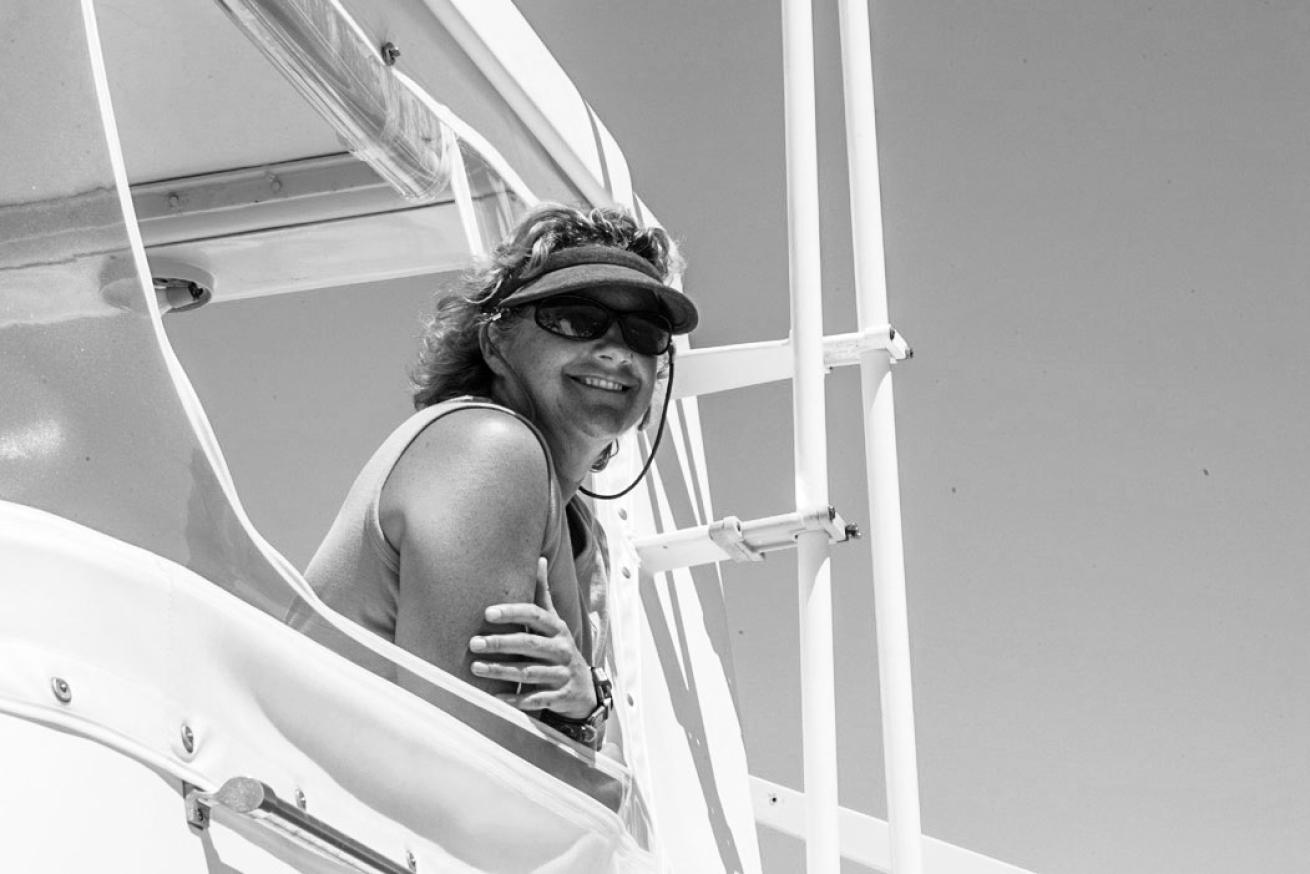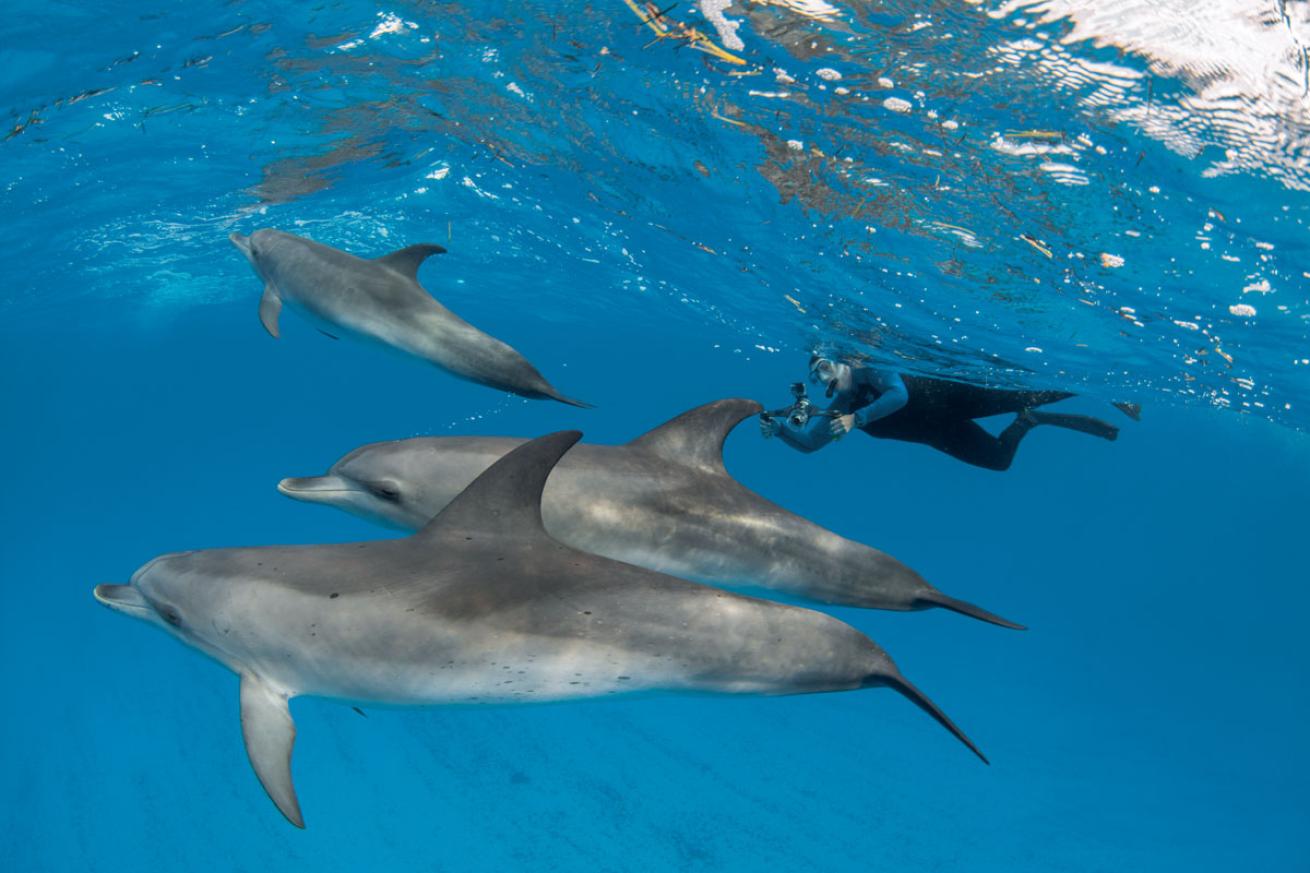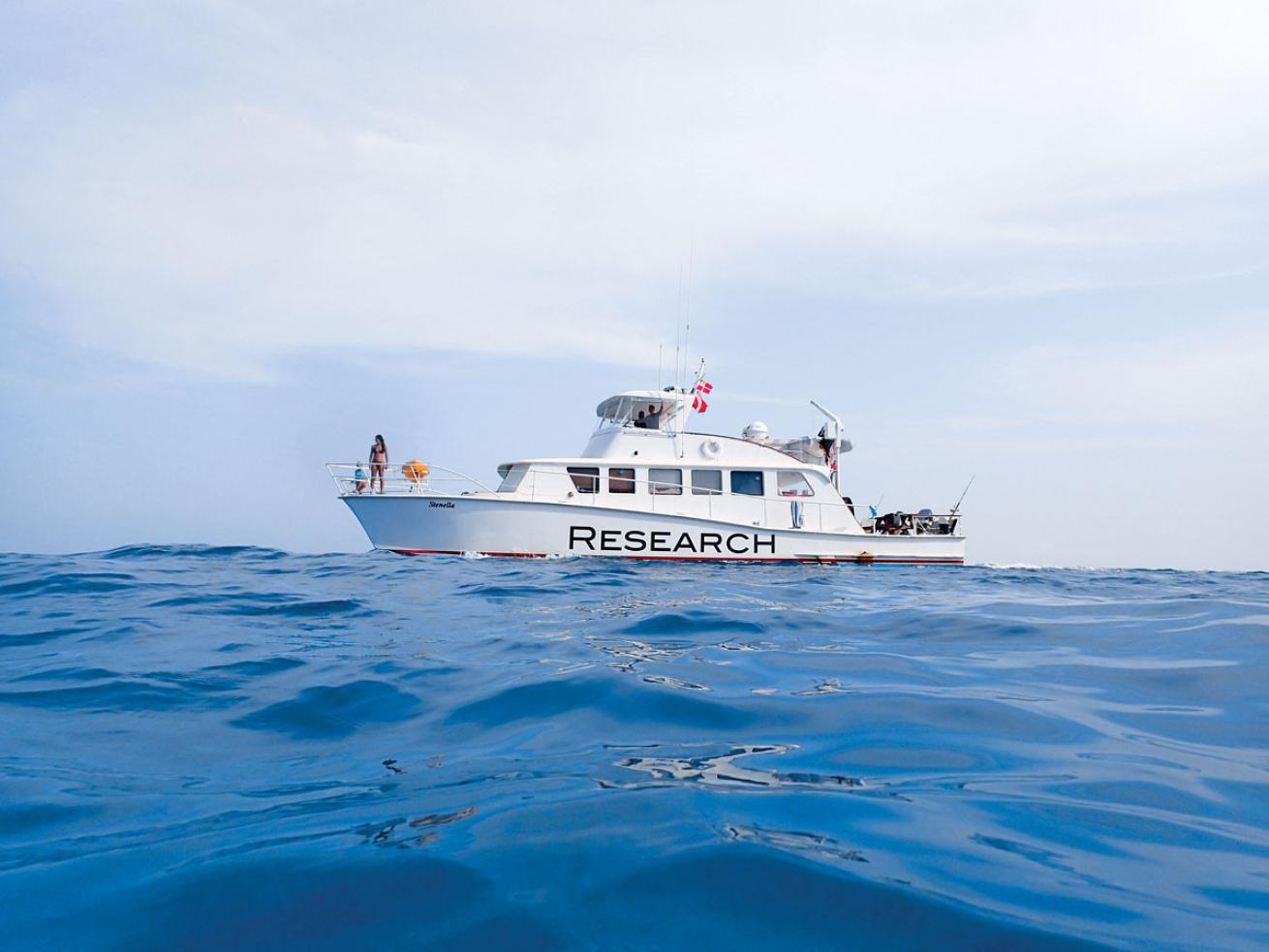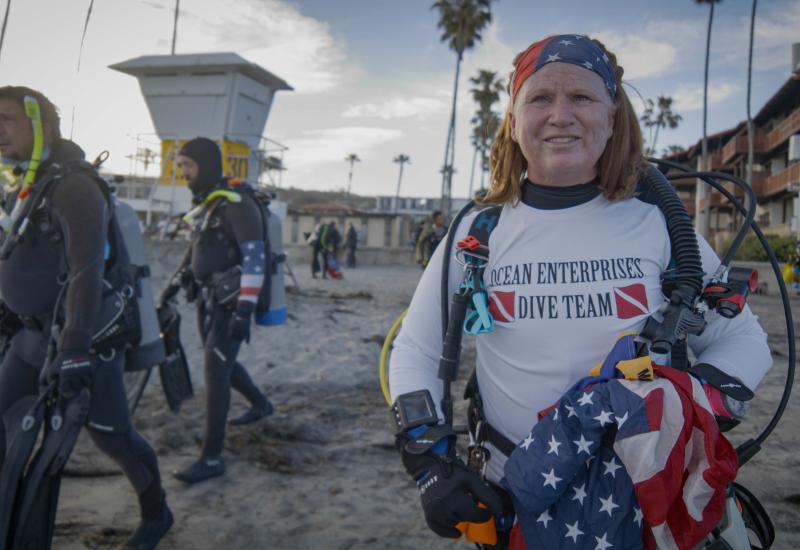Denise Herzing Earns Sea Hero Honors for Bahamas Dolphin Research
Year Dive Certified:1975
Age When Certified: 19
Dive Certification Level: Open Water Diver
Words to Live By: “Never give up, never surrender.”—Galaxy Quest
What has Denise Herzing learned in decades of close observation of two species of dolphins inhabiting a single Bahamas study area? For one, the importance of individuality. “Dolphin society is only as resilient as its diversity of individuals, perhaps yet another lesson for humans,” Herzing says. For her work as founder and research director of the Wild Dolphin Project, Herzing is our July issue Sea Hero.

Courtesy Denise HerzingDenise Herzing
Q: The Wild Dolphin Project is the longest-running underwater study of dolphins in the wild; what special insights or perspective does that long view afford?
A: I choose the Bahamas to work in because I want to observe dolphins underwater. Although you can use identification techniques from dorsal-fin photos from the surface, if you want to study the details of their communication system, you need to watch them underwater.
It’s important to have baseline information on any species—with mammals, it is critical to follow individuals for the long term, to get information including health, births, deaths, etc. In our case, studying the society and communication signals is enhanced by having a social context. Knowing whether dolphins are male or female, who they are related to, and what their personalities are really helps us understand the intricacies of their aquatic culture. In a shorter study you would not be able to document long-term relationships. You would also not be able to document the long-term health of the dolphins and also their habitat.
Q: The ocean realm and indeed the planet has changed greatly during your study; have those changes had an observable impact on the animals you study? A: I have observed this free-ranging community of dolphins every summer since 1985 on Little Bahama Bank. In 2004 and 2005, our study area was the bull’s-eye for two hurricanes, Frances and Jeanne. After these storms, we documented a loss of 30 percent of both the Atlantic spotted dolphin and bottlenose dolphins in our communities. This was a devastating event for them; we watched as they altered their social behavior and patterns for four years until it finally stabilized.
If hurricanes are getting more frequent and stronger because of climate change, you could say that this did affect them. But the most obvious climate impact occurred in 2012 and 2013. In the summer of 2013, we arrived at our study site and 50 percent of the dolphins were nowhere to be seen. After spending a month looking for them in the far reaches of our study area, we got a report from a dive boat that they thought they saw some of our regular individuals at a site 100 miles away on Great Bahama Bank.
Sure enough, when we reached the new area, there they were, acting normal but in a completely new area. There was already a local resident community of dolphins living there, so we have been monitoring their integration with the locals. But why did they move to this new area after being resident for over three decades in our original study site? After eliminating other possibilities—orcas, noise pollution—we worked through some data from a NOAA site that included chlorophyll-level info (a proxy for plankton/fish) and other environmental data. We concluded that chlorophyll levels in the dolphin area had dropped significantly over some years, and likely resulted in a food crash. We had noticed anecdotally that their nocturnal prey (squid, flying fish) had not been around on the deep-water edge for years. So even this slight adjustment in the food change likely caused the dolphins to move to an analogous ecological site far away.
What caused this drop? We really don’t know. A lot of things have been changing in the Bahamas—a decade of constantly increasing wind speed, changing predominate wind direction and other things yet unmeasured. The sad news is that the recent data also shows a continued drop in the whole northern area of the Bahamas. So our job is to continue monitoring these dolphins and tell the story of climate change and the affect it has on marine mammals.

Courtesy Wild Dolphin ProjectThe Wild Dolphin Project for 35 years has studied a group of bottlenose and Atlantic spotted dolphins in the same Bahamas study areas.
Q: WDP is known also for its noninvasive methods; what are the challenges and benefits of such an approach?
A: The largest benefit is that you can build trust with the animals. It’s a bit like an anthropological approach, in the sense that you might first observed a society, learn the communication signals, and only then try to interact and test some of the communication signals, all the while knowing who is who and their relationships, to interpret the meaning of their language.
In our case, noninvasive observations allow us to document their behavior underwater on a regular basis and in some detail. Of course you don’t want them to be too habituated, and you must learn and respect any communication signals they direct at you, because they do use what they have to communicate. There are times that they are in the middle of a big fight and they give us signals that they don’t want us in the water, so we get out. It’s a fine line, but we are very careful about monitoring their disturbance.
I decided years ago that I did not want to take them out the water, even temporarily, to satellite tag them. Of course tagging can give you valuable information you can’t get any other way. But since my priority was to build their trust so that we might observe natural behavior, tagging was out. There are some temporary, less-invasive tags, but nothing that really works for a long period of time that is not attached through a dorsal fin. In 2018 we did have a stranded dolphin from our resident group that was rehabilitated in the Bahamas. In that situation, we did, with multiple research groups, satellite tag and release him, since he was already out of the water. The four months of location data that we got from him was amazing. This male dolphin traveled to parts of the Bahamas that we have not surveyed. He ended up back at home with his group, after his two-month swim-about, so it had a happy ending. So different techniques give you different information, but since the Bahamas is unique in the world for regular clear water observations, I have tried to make use of this situation to observe underwater behavior that is impossible to observe in most parts of the world.
Q: What can dolphins teach us? Will we ever be able to communicate more deeply with them, or any ocean species?
A: Dolphins can teach us many things about a healthy normal aquatic society and how the group survives. We have a lot of knowledge about primate groups, but observing dolphins underwater is even more difficult. Dolphin society has many parallels to terrestrial mammals: It is made up of individuals with personalities, it has a social structure that requires both learning and teaching opportunities, including discipline and relationship-building, and it has survival challenges like any society. One of the most interesting, and unexpected, observations during 35 years has been the intimate relationships between the two species of dolphins and how they coexist. How do two species overlap and share space and resources? This is something that humans could learn from dolphins. Two species may interact and play together but still squabble over food or mates. Yet when danger appears, having an ally or neighbor that knows you or your family, can make a difference in your survival.
I believe that with all the new cutting edge technology, including Artificial Intelligence tools and Deep Learning, we will eventually come to understand many other species and the complexity of their communication signals. Using that information to communicate across species barriers is perhaps our greater challenge. Do we need to? What could we do together with another species? Humans will need to decide if we want to interact on that level, and if so, can we do it so it is mutually enhancing and beneficial? Or will we just use another species for our own purposes? Myself, I truly believe that we will find other life in our galaxy someday. If we do, are we prepared to assess it and communicate with it for mutual gain? That is the question.
Q: What do you view as the greatest challenges in marine conservation? How are these challenges reflected in your work?
A: There are so many challenges, it’s sometimes hard to focus on one. I would say that with all the changing environments and resources, just monitoring the planet and species will be critical. So technology is needed for both local and global-scale monitoring. For example, one of the technologies we have been using since our mass exodus of dolphins in 2013 has been Passive Acoustic Monitoring (PAM). Used around the world for marine mammals, this technology allows us to listen and record 24/7 in areas that we can’t monitor in person. We actually located some missing dolphins by utilizing these kinds of data one summer. Although expensive and with its own challenges, we can learn to gather acoustic signals in both far away and deep-water locations. It is through the interpretation and analysis of the signals where we can ask and answer questions that would normally be outside our reach. PAM is also a way to get baseline information as environments and human activity changes. Of course, to be useful, all of this knowledge needs to be put to use in government planning, public awareness, etc., to change both laws and human behavior.
Q: What's been your most satisfying moment? Your most surprising moment? A: I have found great satisfaction in being able to tell the story of a dolphin society, over the decades, in all its details. What has been most surprising to me is the importance of individuality in the larger dolphin society. Dolphin society is only as resilient as its diversity of individuals, perhaps yet another lesson for humans.

Courtesy Wild Dolphin ProjectWDP’s research vessel.
Q: How can our readers help protect wild dolphins?
A: Dolphins have many issues around the globe and most, if not all, are related to human population growth and behavior. First and foremost we should not love them to death. They are not gurus, they are not in need of human attention, and they are not there for our pleasure. I would say minimizing disturbance of any wildlife is very important in general.
Second, support your local policies and laws that help protect dolphins, including regulations on fishing and pollution (balloons and plastic kill many species from ingestion, for example). Be a voice and speak up if needed in your communities. We must be the voice for many species. And many nonprofits like my own Wild Dolphin Project rely not only on volunteers but memberships to sustain their work, so support who you can.
Q: Who are your “sea heroes"?
A: As a student I was inspired simultaneously by Jacques Cousteau, for opening up the underwater world to us, and by Jane Goodall and other primate researchers who stood as examples of determined, long-term non-invasive techniques of observation that I decided to apply to dolphin research. Although every researcher has had some issues in their learning process, these heroes were inspirational to me.
Today, I continue to admire Sylvia Earle and others who continually bring awareness to ocean issues. And there are many heroes unknown to the larger world that work in small parts of their ocean world who should also be recognized.
Q: Is there anything we did not ask that you would like readers to know?
A: Although my focus has been on a specific resident community of dolphins, I share the larger concern for what we are doing to our planet. There are many species and societies without “voices” and although we may not be able to study all of them, we can save and protect their ecosystems and habitats. It might be decades later when we realize what is on some reef or in some deep part of the ocean, but without a healthy habitat, no species can survive. So it’s important to keep the big picture in mind during all of our work and exploration. Simultaneously the dive community is providing models for kids and adults alike, showing that everyone can do something for the planet.
Each Sea Hero featured in Scuba Diving receives a Seiko Prospex SRPE05 watch valued at $595. For our December issue, judges select a Sea Hero of the Year, who receives a $5,000 cash award from Seiko to further his or her work. Nominate a sea hero at /seaheroes.










